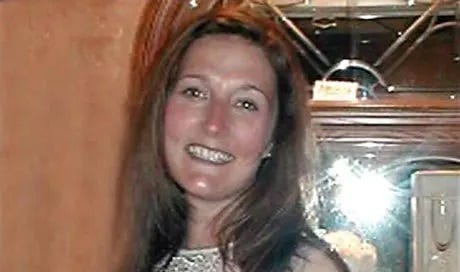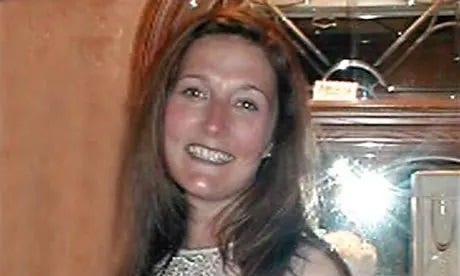The murder of Suzanne Pilley. Murder without a body.
Murder is described as a wilful act that causes the destruction of life. If someone is missing and no body has been found, how can someone be convicted of their murder? According to Scottish law, if no body can be found then there must be enough circumstantial evidence to show that the accused has killed the victim, that the intention of killing was present and that the accused has likely disposed of the body.
The murder of Suzanne Pilley and the conviction of her former lover David Gilroy is one example of a murder without a body and now an infamous case in Scotland.
Suzanne Pilley was a 38 year old book keeper who worked at Infrastructure Management in Thistle Street, Edinburgh. On the day of her disappearance at 08.36am on her way to work, Suzanne sent a cheerful, optimistic message to her mother about a potential new relationship. She was also seen at the Sainsburys on the corner of St Andrew’s Square and Rose Street before arriving at her work at 08.53am. CCTV images confirm she reached the ground floor entrance to the Thistle Street building but never made it to her desk on the second floor office. She was later reported missing by her parents and colleagues.
It was unusual for Suzanne not to turn up for work and this caused some concern amongst her colleagues who contacted her parents at 12.45pm. Her parents were also immediately concerned. This was heightened when there was no sign of Suzanne at her flat. Money and her passport were also left there. They then reported her missing at 8pm that evening.
As police began investigating Suzanne’s disappearance, they soon became aware of an affair between Suzanne and a man named, David Gilroy, another employee at Infrastructure Management. At the time of Suzanne’s disappearance, Gilroy was 47 years old, married to his wife with two children. He usually lived with his family. The relationship between the two was said to have been turbulent and it was soon established that Suzanne had recently attempted to break off the affair as she had found someone else. In the lead up to Suzanne’s disappearance, Gilroy was said to have become obsessive, making multiple phone calls, leaving voicemails and sending several messages a day.
It might be worth noting at this point, that criminology tells us that women are at greater risk of violence when they attempt to break off a relationship with a man, so it was no surprise that David Gilroy soon became a person of interest.
Colleagues in the office of Infrastructure Management would later report seeing David Gilroy in the office on the morning of Suzanne’s disappearance. He was said to be near the photocopying area, near to the back stairs to the basement. He was described as being out of sorts, shocked and stressed. Later in the morning, he excused himself from the office and made his way to his mother’s house who then took him to collect his car from his family home. He returned to the office with his car and was seen on several occasions visiting the garage basement for an unknown reason.
When speaking with David Gilroy, the police soon established that he was the last person to have seen Suzanne alive. He told them he had travelled to Lochgilphead, several miles away in Argyll to carry out a pitch inspection at the local high school. This was not a scheduled trip to the high school and colleagues within the office were not aware that the trip was happening. A later inspection of Gilroy’s vehicle would find significant damage to the underside of the car and CCTV footage documenting Gilroy’s journey highlighted that the journey had taken longer than would be expected. On his return and speaking with the police, it was noted that Gilroy had several injuries to his hands, forehead and arms. Police decided to photograph the injuries on Gilroy and the police photographer noted that Gilroy had attempted to conceal the injuries with makeup.
The prosecution were able to present further evidence against Gilroy at the trial. They highlighted that Gilroy had pestered Suzanne, with more than four hundred messages a month in the run up to her disappearance, all of which stopped at the same time she disappeared.
The police had also used specially trained cadaver dogs, who are able to detect when a dead body has been present at a given location. They highlighted significant areas of interest in both the basement of Infrastructure Management and in the boot of Gilroy’s car.
Proof of life enquiries also failed to find any activity that indicated Suzanne was alive.
It was ultimately put to the jury that Gilroy had dumped Suzanne’s body in the remote area of the Rest and Be Thankful in Argyll shortly after her disappearance. A vast, mountainous area that Gilroy would have driven through to reach the Lochgilphead high school.
Initial appeals made by Gilroy against his conviction relate to his treatment as a witness and later as a suspect. The appeal centred on how this process was handled and how he was cautioned by police. The appeal was rejected. To this day, David Gilroy is still fighting against his conviction. In May 2014 he applied via the Freedom of Information Act requesting all CCTV recovered as part of the investigation:
“A copy of the comprehensive list of the CCTV which was recovered by the Police, as part of their investigations into my case. The CCTV … is that which was detailed in the BBC documentary.
I am seeking the full list of recovered CCTV with the date it was obtained by the police, the details of when the images occurred, and the location to which it refers, as detailed in each ‘Lothian & Borders Police Certificate in terms of section 283 of the criminal procedure (Scotland) act 1995"
It is unclear what purpose David Gilroy may have for obtaining the CCTV footage but the request was not granted. His family, who continue to protest his innocence, have also made reference to CCTV in their campaigns and appeals.
The Gilroys state:
“We would also like to say that if we thought for one minute that David committed such a heinous crime, we would certainly be asking him to put the Pilleys minds at rest. Since the 2012 trial, as every year has gone by, it has become clearer and clearer to us that the evidence given at the trial shows that the Crown theory was well-nigh impossible. For over two years now we have been trying to establish reasonable access to the original CCTV footage for our expert who has been considering the detail that others have not taken the time to look at properly.
If there was no such crime it follows that there was no cover-up and it will never be possible for a body to be found in Argyll. At this stage, ten years on from the events, we call on the Chief Constable to ensure that fresh eyes, from our expert and a new lead on Police Scotland’s ongoing review team, give everyone a chance to bring this sad story to a close.”
Their campaign attempts to pick holes in intricate aspects of the case. In their own words, they claim they are challenging a “narrow point of law”. According to the Gilroy Family website an alternative line of enquiry has been suggested by Gilroy relating to CCTV evidence not presented in court. This alternative theory does not appear to be in the public domain. At the time of writing the last update on the David Gilroy family website was in May 2020.
Sadly, Suzanne’s father died without ever finding his daughter. On the 10th anniversary of her disappearance, Suzanne’s family spoke of how they longed to give her a proper goodbye. They also back a new law in Suzanne’s name, that is now due to be implemented in Scotland.
Suzanne’s law will see changes to parole board rulings in cases where a killer refuses to reveal the location of a victim’s body. This will now be taken into consideration by parole boards when deciding if a prisoner is fit for release. However, opposition parties argue that the changes to the rules do not go far enough. The changes still do not guarantee that failure to disclose the location of a body will be taken as grounds to reject a prisoner’s release.
What do you think about the changes to the law and do they go far enough?
David Gilroy continues to serve his 18 year sentence in prison. At the time of writing, Suzanne has never been found.
Did you enjoy reading this article? If so, please subscribe to the blog to receive new Scottish crime cases direct to your inbox. Substack subscribers are the first to receive new cases from the Scottish True Crime blog before they are published anywhere else.
If you REALLY enjoyed the article, please consider supporting the Scottish True Crime blog y buying me a coffee. Your support is greatly appreciated!





